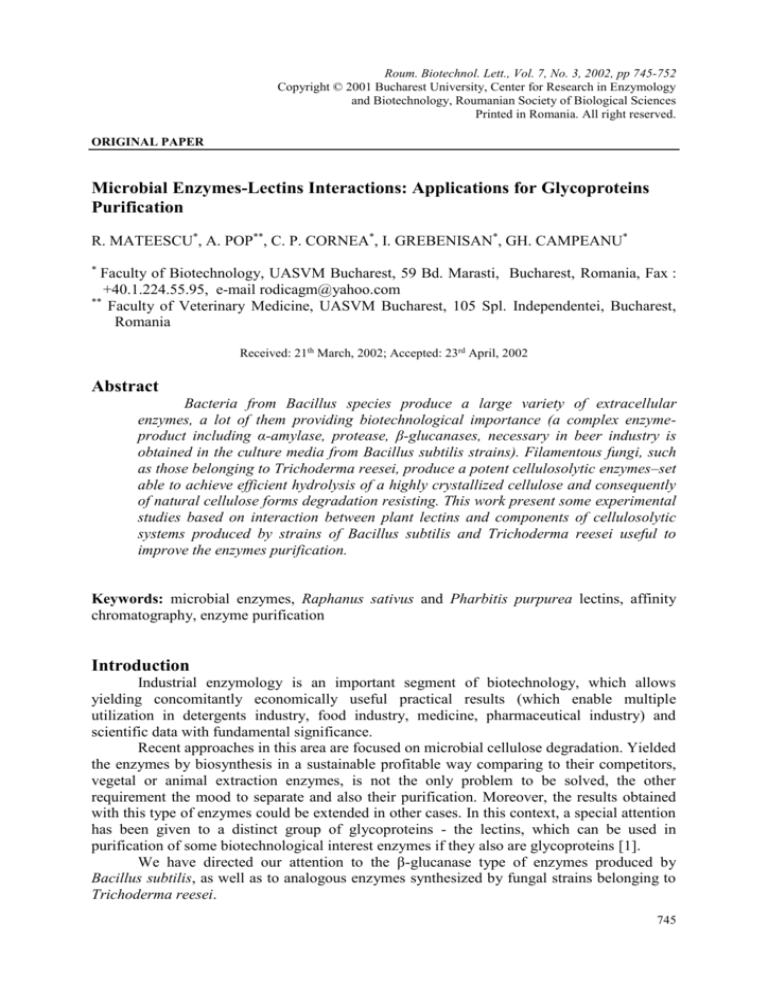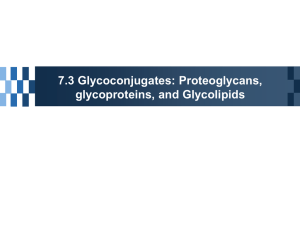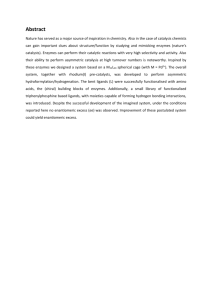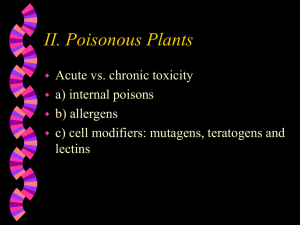
Roum. Biotechnol. Lett., Vol. 7, No. 3, 2002, pp 745-752
Copyright © 2001 Bucharest University, Center for Research in Enzymology
and Biotechnology, Roumanian Society of Biological Sciences
Printed in Romania. All right reserved.
ORIGINAL PAPER
Microbial Enzymes-Lectins Interactions: Applications for Glycoproteins
Purification
R. MATEESCU*, A. POP**, C. P. CORNEA*, I. GREBENISAN*, GH. CAMPEANU*
*
Faculty of Biotechnology, UASVM Bucharest, 59 Bd. Marasti, Bucharest, Romania, Fax :
+40.1.224.55.95, e-mail rodicagm@yahoo.com
**
Faculty of Veterinary Medicine, UASVM Bucharest, 105 Spl. Independentei, Bucharest,
Romania
Received: 21th March, 2002; Accepted: 23rd April, 2002
Abstract
Bacteria from Bacillus species produce a large variety of extracellular
enzymes, a lot of them providing biotechnological importance (a complex enzymeproduct including α-amylase, protease, β-glucanases, necessary in beer industry is
obtained in the culture media from Bacillus subtilis strains). Filamentous fungi, such
as those belonging to Trichoderma reesei, produce a potent cellulosolytic enzymes–set
able to achieve efficient hydrolysis of a highly crystallized cellulose and consequently
of natural cellulose forms degradation resisting. This work present some experimental
studies based on interaction between plant lectins and components of cellulosolytic
systems produced by strains of Bacillus subtilis and Trichoderma reesei useful to
improve the enzymes purification.
Keywords: microbial enzymes, Raphanus sativus and Pharbitis purpurea lectins, affinity
chromatography, enzyme purification
Introduction
Industrial enzymology is an important segment of biotechnology, which allows
yielding concomitantly economically useful practical results (which enable multiple
utilization in detergents industry, food industry, medicine, pharmaceutical industry) and
scientific data with fundamental significance.
Recent approaches in this area are focused on microbial cellulose degradation. Yielded
the enzymes by biosynthesis in a sustainable profitable way comparing to their competitors,
vegetal or animal extraction enzymes, is not the only problem to be solved, the other
requirement the mood to separate and also their purification. Moreover, the results obtained
with this type of enzymes could be extended in other cases. In this context, a special attention
has been given to a distinct group of glycoproteins - the lectins, which can be used in
purification of some biotechnological interest enzymes if they also are glycoproteins [1].
We have directed our attention to the β-glucanase type of enzymes produced by
Bacillus subtilis, as well as to analogous enzymes synthesized by fungal strains belonging to
Trichoderma reesei.
745
R. MATEESCU, A. POP, C. P. CORNEA, I. GREBENISAN, GH. CAMPEANU
The aim of our work was to investigate the interaction between two plant lectins and
components of cellulosolytic systems produced by strains of B.subtilis and T.reesei in order to
improve the methodology of microbial glycoenzymes purification by affinity chromatography
on immobilized lectins.
Materials and methods
Biological materials. Several B.subtilis and T.reesei strains from the collection of
Faculty of Biotechnology were tested in our experiments. Finally, one bacterial strain
designated as B.subtilis 1.65 and a strain of T.reesei were used. The source of lectins was the
seeds of Raphanus sativus or Pharbitus purpurea purified as described previously [2].
Culture media. In order to maintain Bacillus cultures and to select some new strains
it has been used nutrient agar. For the cultivation of fungal strains was used malt extract 1%
medium. A synthetic medium previously described by Ishaque and Kluepfel [3] supplemented
with 1% cellulose (carboxymethylcellulose = CMC or Avicel PH101) was used. For enzyme
purification, 100 ml of liquid synthetic medium with Avicel PH101 as carbon source were
inoculated with fungal spore suspension or bacterial suspension and incubated at 30-32oC for
4 days.
β-glucanase activities were determined on carboxymethylcellulose (CMC),
crystalline cellulose (Avicel PH101) or 1% β-glucan from malt flour (prepared as described
Jorgensen as substrate[4]. The assays were done at 45oC and the substrate concentration was
10mg/ml (CMC or Avicel PH101). Reducing sugar formation was determined by the
dinitrosalicilic acid (DNS) method of Miller at al. [5]. One international unit of activity (IU)
equals 1mol of reducing sugar produced/min. Protein was determined by the dye-binding
assay of Bradford.
The glycoproteic nature of some components of celullolytic complex produced by
selected microorganisms was proved by PAS reaction[6]. Based on the fact that components
of microbial cellulase systems are glycoproteins, the β-glucanase-lectins interactions were
determined by Ouchterlony double-diffusion technique [7].
Affinity chromatography on immobilized lectins
Lectins extracted from Raphanus sativus seeds were immobilized with 25%
glutaraldehyde and used for cellulase purification [8]. 20ml of culture filtrate were applied on
immobilized lectins (batch technique) and the mixture was incubated for 5h at 4oC. After
centrifugation, the sediment was washed with distilled water (3 times). The enzymes were
eluted with 50mM glycine-HCl buffer, pH 3.0 containing 0.5M NaCl.
SDS-PAGE was performed in 8% polyacrylamide gels in the presence of 0.1% SDS
by the method of Laemmli [9]. When the separated proteins were to be stained for enzyme
activity, the separating gel contains cellulose as substrate and the steps in detection of
cellulase activity were performed as described Schlochtermeyer et al. [10].
Results and Discussions
Our previous studies regarding the interactions between enzymes produced by
different strains of Streptomyces sp. and some plant lectins allowed the elaboration of a
specific protocol, which was applied for the microorganisms investigated in this work [2].
Lectins were purified according a method described previously[6].
Following double diffusion in agarose gel, precipitation lines were highlighted
implicitly interactions between culture media compounds from Bacillus subtilis and partly
purified lectinic mixture from seeds of Raphanus sativus. Based on these results, the next step
in our study was the identification of the glycoproteins, which interact with the lectins.
746
Roum. Biotechnol. Lett., Vol. 7, No. 3, 745-752 (2002)
Microbial Enzymes-Lectins Interactions: Applications for Glycoproteins Purification
It is well known that, both categories of microorganisms used in this study, Bacillus
subtilis and Trichoderma reesei are capable to synthesis a very large range of hydrolytic
enzymes [11]. After highlighting the precipitation lines as a result of interaction between
culture filtrates and lectinic extracts, equal volumes of lectinic extract and culture filtrate were
mixed, incubated over night at 4°C and after centrifugation two phases were separated:
supernatant (Sup) and sediment (Sed). Both phases were subjected to further studies
concerning the identification of microbial glycoproteins involved in the interaction with
Raphanus lectins.
Lectins- Bacillus subtilis enzymes interactions
In case of the interaction between Bacillus subtilis enzymes and Raphanus sativus
lectins, results reveal that amylolytic activity of the culture filtrate was entirely recovered in
Sup phase, therefore this β-glucanase enzyme is not involved in the interaction with lectins.
On the other hand, β-glucanase activity (using 1% β-glucan from malt flour as
substrate) determined in Sup phase represents approximately 50% from global activity of the
culture medium submitted to interaction. Correlating these results with the fact that in resulted
precipitate (Sed) can be recovered only β-glucanase activity, we could conclude that only βglucanase interacts with a lectinic part of the extract from Raphanus sativus seeds.
The investigation of control samples showed the surprising presence of a low βglucanase activity (6U/mL/min) in the lectinic crude extract.
The survey of global -glucanase activity from Bacillus subtilis culture medium +
lectinic extract was estimated as 21U/mL/min in Sup + Sed, comparing to 22U/mL/min in
controls separately investigated, that suiting to a 95% recovery proportion.
Assuming that the origin of entire β-glucanase activity detected in the precipitate is
from the culture medium, that means the enzymatic activity detected in the Sup of lectinic
extract represent the unbound enzyme (the lectin-enzyme ratio is favourable to the enzyme).
The confirmation of this hypothesis has been materialized through a distinct series of
experiments in which culture medium/lectinic extract ratio has been varied, the bulk of
lectinic extract being maintained constant and varying the amount of culture medium.
Results revealed that for small-sized amounts of culture filtrate it was recovered in
supernatant the same enzyme activity as in Raphanus extract: it means that microbial enzyme
is involved in the affinity interaction. The best output with a view to obtaining maximum
amount of precipitated enzyme results for a volumetric ratio culture medium/lectinic extract
of 4/5 (Table 1).
Table 1.Variation of precipitation efficiency of -glucanase from culture filtrate by
modifying filtrate/lectinic extract ratio
Culture
filtrate (ml)
0.1
0.2
0.3
0.4
0.5
0.6
Lectinic
-glucanase in
extract (ml) supernatant (U/mL/min)
0.5
6
0.5
6
0.5
6
0.5
6
0.5
8.6
0.5
9.8
Roum. Biotechnol. Lett., Vol. 7, No. 3, 745-752 (2002)
Efficiency of
binding (%)
100
100
100
100
90
60
747
R. MATEESCU, A. POP, C. P. CORNEA, I. GREBENISAN, GH. CAMPEANU
The treatment with glutaraldehyde of the lectinic extract from Raphanus resulted in
a insoluble proteinaceous precipitate, which have been used in the subsequent steps of
microbial glycoenzymes purification.
Affinity chromatography has been carried out by batch technique. To the insoluble
lectinic polymer were added 10 ml microbial culture filtrate and incubated overnight in
refrigerator. The various enzymatic activities of the culture filtrate are presented in (Table 2).
Table 2. The level of different enzymes produced by B.subtilis B36
Total
protein Proteolytic activity α-amylase
β-glucanase
(mg/ml)
(U/ml/min)
(U/ml/min)
(U/ml/min)
38
7.85
382
43.7
After centrifugation, the level of protease, α-amylase and β-glucanase in the resulted
supernatant has been analysed and the results are shown in (Table 3).
Table 3. Enzymatic activities in the supernatant obtained after interaction of microbial
proteins and immobilized lectins
Total protein Proteolytic activity α-amylase
(mg/ml)
(U/ml/min)
(U/ml/min)
28.5
7.85
379.5
β-glucanase
(U/ml/min)
2
Separately, the sediment resulted after centrifugation was washed with distilled
water in order to remove contaminating proteins and the enzymes we were interested in have
been eluted with glycocol-HCl buffer, pH 3.0, containing 0.5M NaCl (Table 4)
Table 4. Enzymatic activities in the sample obtained after the elution of the bound enzymes
(after interaction of microbial proteins and immobilized lectins)
Total protein Proteolytic activity α-amylase
(mg/ml)
(U/ml/min)
(U/ml/min)
4
0
0
β-glucanase
(U/ml/min)
38
Supernatant resulted includes only -glucanase and it was used in the subsequent
stages for the characterization of the enzyme. The polyacrilamide gel electrophoresis of the
enzyme obtained with this method shown the presence of a single proteic band, of
glycoproteic type with β-glucanase activity.
748
Roum. Biotechnol. Lett., Vol. 7, No. 3, 745-752 (2002)
Microbial Enzymes-Lectins Interactions: Applications for Glycoproteins Purification
a
b
Figure 1. PAGE pattern of the enzyme preparation obtained by affinity chromatography on immobilized lectins
a) Schiff reagent (PAS technique); b) gel detection of enzymatic activity.
Since a lot of studies demonstrated glycoenzymes stability by binding various
chemical agents to the glucidic region of the molecules [12], in this work we examined the
consequence of coupling the lectin with bacterial -glucanase. The interaction enzyme-lectins
was conducted in centrifuge test tubes for 24 h. The precipitate enzyme-lectin was rendered
soluble in acetic acid – sodium acetate buffer, pH 5.0 and the -glucanasic activity was
determined. The values obtained were higher than those resulted for the culture medium
submitted to the interaction discussed in the present paper and also than those registered for
the purified enzyme.
The conclusion resulted from our experimental data is that the lectin is bound at the
glucidic region of the enzyme, forming an extremely active supermolecular aggregate and
inducing some changes in the conformation and function of to the enzyme.
Lectins – Trichoderma reesei enzymes interaction
It is known that Trichoderma sp. produced different glycoenzymes, including βglucanase [13]; for this reason we tested different types of plant lectins for interaction with
fungal culture filtrate. The first group of lectins included those with glucose/manose,
specificity since the literature data reporting the glycoproteic nature of fungi cellulases
suggested the existence of these oses into the prosthetic group [14, 15].
Interaction lectins – enzymes has been proceeded by double diffusion in agarose gel,
(Ouchterlony technique), taking under consideration purified lectins from Pisum sativum,
Lens culinaris, Con A, several isolectins from Vicia sort and Pharbitis purpurea. Excepting
the lectin from Pharbitis in which case the precipitation lines come out after diffusion
vanished during the phases of washing and staining, no interaction has been observed,
although such interactions had been cited in literature, at least in the case of Con A [1].
Reaction in the presence of Pharbitis lectin could be explained through the possibility that the
affinity super-molecular aggregate dissociate into the physiologic serum during washing
phases. Lack of interaction during the experiment carried-out might be due to the fact that the
specific glucide is bound into glycoenzyme structure in a way that hinders the lectin in its
recognition. The explanation – a quantity-related one – might be the following: despite of
high enzymatic activity, the culture filtrate features low proteic content and that might cause
the lack of interaction evidence (precipitation line).
Roum. Biotechnol. Lett., Vol. 7, No. 3, 745-752 (2002)
749
R. MATEESCU, A. POP, C. P. CORNEA, I. GREBENISAN, GH. CAMPEANU
Subsequent experiment stage consisted in estimating through the same pathway the
interaction with lectins of various specificities, N-acetylglucosamine and N-acetylgalactose,
namely lectins from tomatoes, potatoes, castor-oil plant, soybean, Datura inoxia, Sophora
japonica.
Results obtained were alike but no precipitation lines were registered. The new
lectins, less known or featured, have been the subject for the interaction with enzymes from
Trichoderma reesei culture medium. These lectins appeared as partly purified extracts
obtained from seeds yielded by roumanian flora: Geum urbanum (common bennet),
Calendula officinalis (marigold), Papaver somniferum (poppy) and Raphanus sativus
(radish), nevertheless showing an indisputable lectinic activity. Precipitation lines have been
observed only in the case of lectinic extract from Raphanus sativus (Figure 2).
Figure 2. Interactions between T.reesei culture filtrate and Pharbitis lectins or Raphanus lectins. Culture filtrate
was applied into the central hole; the other holes formed are for applying lectins with various specificities.
Assuming that compounds precipitated onto the agarose gel ought to precipitate also
into the test-tube, the interaction has been accomplished, consequently being identified the
nature of microbial compounds in accordance with the following diagram:
3 ml Trichoderma culture filtrate
+
3 ml lectinic extract
overnight incubation at 40C meanwhile a precipitate is formed
centrifugation at 4000 rpm
precipitate
supernatant
resuspended in 3 ml phosphate – citric acid buffer, pH 4.8
The samples obtained following this scheme were tested for cellulosolytic activity
comparing with the activity of the same type of enzymes in the culture filtrate (used as
control), the results being presented in (Table 5).
750
Roum. Biotechnol. Lett., Vol. 7, No. 3, 745-752 (2002)
Microbial Enzymes-Lectins Interactions: Applications for Glycoproteins Purification
Table 5. Activity of cellulases (C1 and Cx) and -glucosidase from T.reesei culture filtrate
and from the precipitates obtained after the interaction with lectins
Control
C1
Enzymatic activity
2.8
% of enzymatic 10
activity
from 0
precipitates
comparing
with
control values
Cx
200
100
Precipitate obtained
after the interaction
with the lectins from
Raphanus
β-gluc C1
Cx
-gluc
1.55
3.5
100
120.6 -
Precipitate
obtained
after the interaction
with the lectins from
Pharbitis sp.
C1
Cx
-gluc
3.9
2
2.25
134.4 0.5
145.1
8
6
During the interaction with radish lectinic extract, in the precipitate was detected only
cellobiohydrolase activity (C1 cellulase); therefore this enzyme has been one of the affinants
and it can be separated from the other cellulololytic system components from the culture
medium.
First step required for the obtaining of glycoproteins by affinity chromatography on
immobilized lectins refers to lectins immobilization by glutaraldehyde. The insoluble proteic
precipitate (resulted from the lectinic extract) was suspended in 5 ml fungal culture
supernatant, stirring and then incubated overnight at 4oC. After centrifugation the supernatant
resulted in both variants (for each type of lectins, from Raphanus and Pharbitis) was
examined for cellobiohydrolase and β-glucosidase activity. No activity was detected.
In case of Raphanus lectinic polymer, after affinity binding, several washes are
carried out by recurrent centrifugation with physiologic serum and a final elution in citrate
buffer pH 4.7. No washing was performed in case of Pharbitis lectinic polymer as the elution
has been applied in two stages: in physiologic serum resulting the former eluted phase (E1)
and then in citrate buffer pH 4.7 (E2).
Eluted bulk has been fixed to 5 ml so that an artificial dilution of the enzyme could
not occur. Activity of the enzymes known as parts of the cellulosolytic system has been
measured in each one of the eluted samples (Table 6).
Table 6. Enzymatic activity for the different samples containing T.reesei
glycoproteins
Total
C1 activity
Cx activity
-glucanase
protein
activity (UE)
Culture filtrate
0.9
14.5
1000
7.75
Raphanus supernatant 0.61
0
1000
7.75
Raphanus eluted
0.21
16.5
Pharbitis supernatant 0.5
0
1000
0
Pharbitis eluted 1
0.12
0
0
8.6
Pharbitis eluted 2
0.21
15.8
0
0
Electrophoretic investigation of the samples revealed the purity as well as glycoproteic
nature each one of them and the application of double diffusion technique revealed interaction
both with total lectinic extract from Raphanus and the purified lectin with specificity for
fucose (Figure 3).
Roum. Biotechnol. Lett., Vol. 7, No. 3, 745-752 (2002)
751
R. MATEESCU, A. POP, C. P. CORNEA, I. GREBENISAN, GH. CAMPEANU
Figure 3. Interaction of total lectinic extract (A) with culture filtrate from T.reesei (1-4), B.subtilis (5) and the
enzymes obtained after affinity chromatography on Raphanus lectins: from T.reesei (6-7) and B.subtilis (8). In B
are presented the interactions of the same samples with one of the Raphanus lectins: that with fucose specificity.
As it can be seen in fig.3, only T.reesei culture filtrate and purified enzyme interact with
both variants of lectins (total extract and purified lectin), instead the culture filtrate and purified βglucanase from B.subtilis didn’t recognized the lectin with fucose specificity. The conclusion in this
case in that the β-glucanase from B.subtilis does not contain fucose in its glucidic region.
As a result of the experiments described above, the conclusion required is that it is
possible to separate and purify microbial enzymes having biotechnological applications, such
as -1,3-1,4-glucanase from B.subtilis, cellobiohydrolase and -glucosidase from
Trichoderma reesei by affinity chromatography on immobilized lectins.
Acknowledgement
This work was supported by the National Agency for Science, Technology and
Innovation of Romania, grant no. B10/2000-2001.
References
1. V.M. LAKHTIN, in Lectin -Microorganism Interaction, R.J.Doyle and M.Slifkin Eds.,
Marcel Dekker Inc., 1994, p.249-298
2. C. P. CORNEA, A. POP, I. VATAFU, G. CÂMPEANU, M. CIUCĂ, Roum. Biotechnol.
Lett., .4, no.5, p.401-408 (1999)
3. M.ISHAQUE, D. KLUEPFEL, J. Canad, Microbiol., 26, p.183-189 (1980)
4. K.G. JORGENSEN, Beer analysis, De Linskens and H.F.Jackson Eds, Springer Verlag,
1988, p.88-110
5. G.L. MILLER, R.BLUM, W.E. GLENNON, A.L. BURTON, Anal.Biochem., 2, p.127132 (1960)
6. A. POP, A. PUSZTAI, S. BARDOCZ, C.P. CORNEA, M. SERBAN, Rev.Roum.Biol.,
39, 1, p.53-57(1994)
7. O. OUCHTERLONY, Prog.Allergy, 6, 30-37 (1962)
8. A. POP, PhD Thesis, University of Bucharest (1998)
9. U.K. LAEMMLI, Nature, 227, 680-685 (1970)
10. A. SCHLOCHTERMEIER, F. MIEMEIER, H. SCHREMPF, Appl.Environ.
Microbiol.58, p. 3240-3248 (1992)
11. E. A. BAYER, E. MORAG, M. WILCHEK, R. LAMED, Carbohidrate Bioengineering,
eds. Petersen, B.S., Svenss, B.,Pedersen, S., Elsevier Science, 1995, p.251
12. N.R GILKES, B. HENRISSAT, D.G. KILBURN, R.C. MILLER, R.A.J. WARREN,
Microbiol.Rev., 55, p.305-315 (1991)
13. J. KNOWLES, P.LEHTOVAARA, T. TEERI, TIBTECH, 5., 1987, p.255-261
14. W.S. ADNEY, C.J. RIVARD, M., SHIANG, M.E. HIMMEL, Appl. Biochem.
Biotechnol., 30, 165 (1991)
15. K.G. WELINDER, J.W.TAMS, Carbohydrate Bioengeenering, eds. Petersen, S.
B.,Svenson, B., Pedersen, S., Elvesier Science (1995)
752
Roum. Biotechnol. Lett., Vol. 7, No. 3, 745-752 (2002)









